Me 163 kits and accessories
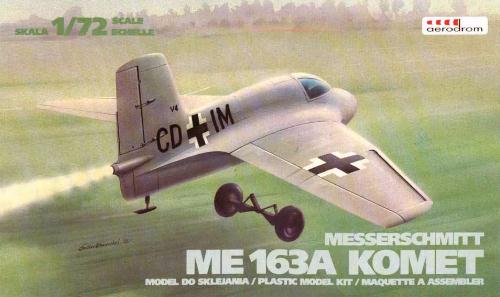
Box art scan by Piotr Kasprzak

The Aerodrom kit was issued in 1997, but I first obtained one here in the Netherlands in 2000. Although the initial reports on the kit were quite negative (see the SAMI review below), it is possible that this is the best Me 163A kit available. The Condor kit is abit of joke shape-wise, and probably too long too. The Aerodrom kit has a very narrow and high rear fuselage, which appears quite correct, although admittedly strange! I haven't checked dimensions against the various sources though. For the moment it's still undecided who makes the best Me 163A kit in 1/72 scale.
Let's take an 'in the box' look first. Shown below is the single sprue with 24 parts that barely fills the rather large box. Two detail views of typical parts are also shown. Moulding quality is mediocre. All parts have a sand-blasted appearance, which reminded me of the Su 15 Flagon kit by Pioneer. This will require sanding of all parts. Engravings are sparse and of the 'I would try it again' variety. My kit showed some mould damage, resulting in some dents and pimples. The canopy is rather bad, but looks like it can be touched up without much trouble. Overall moulding quality looks a lot like a typical limited run model.
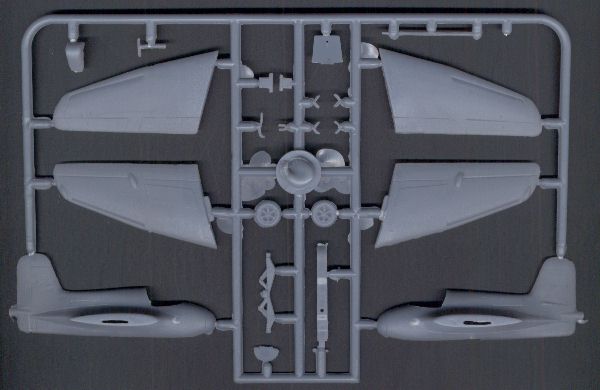
| |

| 
|
Painting instructions are printed in color on the bottom of the box (clever idea) and show an RLM02 overall V8/CD+IM, and V10/CD+IO in RLM76 with RLM74 spots. The latter is the famous R4M rocket equiped example, of which only this single photograph appears to exist. No rocket armament is included, but the Hasegawa Me 262A would be a good source.
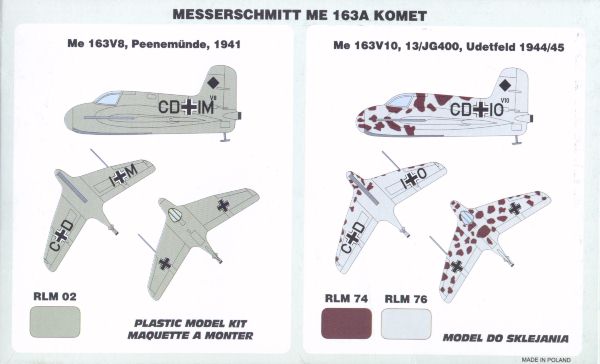
Contrary to the decals discussed in SAMI, my decal sheet looks very nice, extremely thin (Propagteam-like) and very clearly printed.
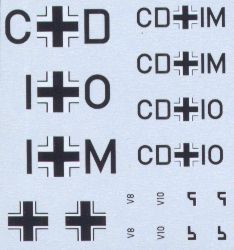
It wasn't until I compared the Aerodrom model to the Condor model that I realised how small the Aerodrom kit is. The difference is so big that I wonder whether the Aerodrom isn't underscale. I have to look into that. For the moment these pictures show the difference. Please note that I modified the Condor kit considerably, including a reduction of the wing chord (3 millimeters).

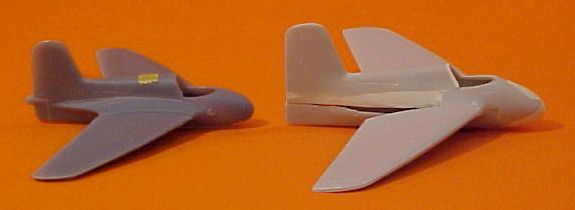
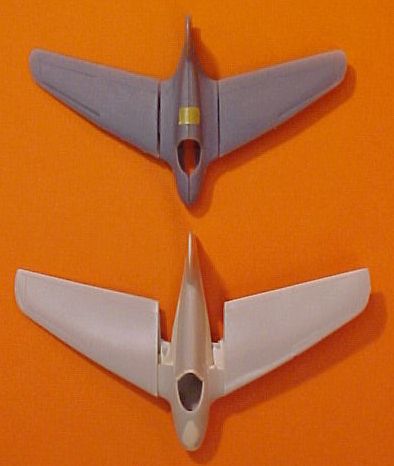
The following information (including the sprue picture below) was found on the Polish 'Scale modeling in Lodz' page by Piotr Kasprzak. Note the different decal sheet and the different color of the plastic.
AERODROM - new firm in the market. In current production are two 1/72 scale kits.
Messerschmitt Me 163A Komet - a long run injection moulded model, consisting of 24 parts. The glue is also included. Sold only as a wholesale item, price US $1.2 approx.
My comment: Kit of correct shape. Decals are unfortunately gloss, not in conformity to the original. Very nice boxart and clear assembly instruction. Good for the beginners and all collectors of Luftwaffe aircraft kits.
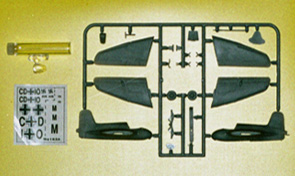
A kit review of the new Aerodrom 1/72 Me 163A kit appeared in the October 1998 issue of SAMI. Ruediger Landmann summarised it as follows:
This is indeed a completely different mould from the Condor kit. It contains 24 parts, moulding is OK with just a little flash. Panel lines are engraved. Canopy is poorly moulded - thick and with many imperfections.
The kit is *way* underscale - about 3 scale feet too short in both length and span, making it closer to 1:100 than 1:72! Fuselage cross section is very bad - way too skinny. This was very obvious in the photo of the built-up kit that accompanied the article. Nose profile is quite wrong as well - reviewer claimed that it was almost more like a 163B than 163A.
Unlike the Condor kit, the landing skid could be built up or down. The review is not clear, but it seems that only the sprung dolly is provided, but this is *far* too wide in track (even for 1/72). The reviewer noted that there are only two struts on the skid when there "should" have been three... but I'm not aware of photos that confirm or deny this (although the back of the Condor box illustrates it). Certainly the 163B had three - but the 163A? If you choose the build the skid down, there is, however, no well or bulkhead above it, meaning that you can see straight up into the fuselage...
The box art depicts leading-edge slots, but it's unclear whether these are on the kit too and the review does not mention these...
Decals are well printed and in register, but like many Eastern European kits, are printed all on one continuous carrier film, which is "thick, glossy, and brittle". The reviewer notes that the decals began to break up once in the water, and were so thick that their borders could not be hidden even with "copious amounts of Johnson's Klear". Decals are provided for "V4" and "V6"
Overall, a fairly negative review, concluded by the reviewer saying that he couldn't really recommend this kit to anybody except kit collectors who might like the nice box that it comes in!